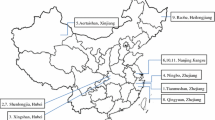Abstract
Q-, C-, and G-banding patterns are described for the germ-line and somatic chromosomes of Miastor sp. The chromosome number in the germ line is 36, which is 3 less than that previously reported for the same cultured line 18 years ago. There are 8 chromosome groups: 8 large acrocentrics, 11 large and medium submetacentrics, 4 medium metacentrics, 4 medium subtelocentrics, 6 medium telocentrics, one medium acrocentric, one small submetacentric, and one small telocentric. All 8 large acrocentrics have a Q-band and an interstitial C-band in the short arm, suggesting that these chromosomes are at least partially homologous (or homeologous) and that the germ line originally was polyploid. Only one other germ-line chromosome, the small submetacentric, has a Q-band and an interstitial C-band. In somatic cells there are 8 chromosomes, 28 chromosomes having been eliminated during early cleavage. Three of the four pairs of somatic chromosomes are heteromorphic, despite the indications of a polyploid origin of the germ-line chromosomes and despite the presence of somatic pairing. Furthermore, there is a great deal of restriction on which chromosomes are retained in somatic cells, and it may be that the same 8 chromosomes are retained by all embryos. The G-banding pattern is not as clear as the other two banding patterns. The findings are discussed in relation to observations in other cecidomyids, and a model for the evolution of the chromosome system of Miastor is presented.
Similar content being viewed by others
References
Bantock, C.: Chromosome elimination in Cecidomyidae. Nature (Lond.) 190, 466–467 (1961)
Camenzind, R.: Die Zytologie der bisexuellen und parthenogenetisehen Fortpflanzung von Heteropeza pygmaea Winnertz, einer Gallmücke mit pädogenetischer Vermehrung. Chromosoma (Berl.) 18, 123–152 (1966)
Ellison, J. R., Barr, H. J.: Differences in the quinacrine staining of chromosomes of a pair of sibling species: Drosophila melanogaster and Drosophila simulans. Chromosoma (Berl.) 34, 424–435 (1971)
Fantes, J., Camenzind, R.: Karyotype and chromosomal banding pattern in Heteropeza pygmaea. Chromosoma (Berl.) 50, 421–429 (1975)
Geyer-Duszyńska, I.: Experimental research on chromosome elimination in Cecidomyidae (Diptera). J. exp. Zool. 141, 391–448 (1959)
Hauschteck, E.: Die Cytologie der Pädogenese und der Geschlechtsbestimmung einer heterogenen Gallmücke. Chromosoma (Berl.) 13, 163–182 (1962)
Jones, K. W.: Chromosomal and nuclear location of mouse satellite DNA in individual cells. Nature (Lond.) 225, 912–915 (1970)
Kahle, W.: Die Paedogenese der Cecidomyiden. Zoologica (Stuttg.) 21, Fasc. 55, 1–80 (1908)
Kraczkiewicz, Z.: Nouvelles recherches sur l'oogenèse et la diminution dans les larves paedogénétiques de Miastor metraloas (Diptera). C. R. Soc. Biol. (Paris) 119, 1201–1202 (1935)
Kraczkiewicz, Z.: Etudes cytologiques sur l'oogenèse et la diminution de la chromatine dans les larves paedogénétiques de Miastor metraloas Meinert (Diptera), Folia morph. (Warszawa) 6, 1–37 (1936)
Kraczkiewicz, Z.: Premiers stades de l'oogenèse de Rhabdophaga saliciperda (Cecidomyiidae, Diptera). Chromosoma (Berl.) 18, 208–229 (1966)
Kunz, W., Eckhardt, R. A.: The chromosomal distribution of satellite DNA in the germ-line and somatic tissues of the gall midge, Heteropeza pygmaea. Chromosoma (Berl.) 47, 1–19 (1974)
Kuntz, W., Trepte, H.-H., Bier, K.: On the function of the germ line chromosomes in the oogenesis of Wachtiella persicariae (Cecidomyiidae). Chromosoma (Berl.) 30, 180–192 (1970)
Nicklas, R. B.: An experimental and descriptive study of chromosome elimination in Miastor spec. (Cecidomyidae; Diptera). Chromosoma (Berl.) 10, 301–336 (1959)
Nikolei, E.: Vergleichende Untersuchungen zur Fortpflanzung heterogoner Gallmücken unter experimentellen Bedingungen. Z. Morph. Ökol. Tiere 50, 281–329 (1961)
Panelius, S.: Male germ line, spermatogenesis and karyotypes of Heteropeza pygmaea Winnertz (Diptera:Cecidomyiidae). Chromosoma (Berl.) 32, 295–331 (1971)
Pardue, M. L., Gall, J. G.: Chromosomal localization of mouse satellite DNA. Science 168, 1356–1358 (1970)
Patil, S. R., Merrick, S., Lubs, H. A.: Identification of each human chromosome with a modified Giemsa stain. Science 173, 821–822 (1971)
Reitberger, A.: Die Cytologie des pädogenetischen Entwicklungszyklus der Gallmücke Oligarces paradoxus Mein. Chromosoma (Berl.) 1, 391–473 (1940)
Seabright, M.: A rapid banding technique for human chromosomes. Lancet 1971 II, 971–972
Sumner, A. T.: A simple technique for demonstrating centromeric heterochromatin. Exp.Cell Res. 75, 304–306 (1972)
Sumner, A. T., Evans, H. J., Buckland, R. A.: New technique for distinguishing between human chromosomes. Nature (Lond.) New Biol. 232, 31–32 (1971)
White, M. J. D.: The cytology of the Cecidomyidae (Diptera). II. The chromosome cycle and anomalous spermatogenesis of Miastor. J. Morph. 79, 323–369 (1946)
White, M. J. D.: Cytological studies on gall midges (Cecidomyidae). Univ. Texas Publ. 5007, 1–80 (1950)
White, M. J. D.: Animal cytology and evolution, 3rd ed. Cambridge and London: Cambridge University Press 1973
Author information
Authors and Affiliations
Rights and permissions
About this article
Cite this article
Bregman, A.A. Q-, C-, and G-banding patterns in the germ-line and somatic chromosomes of Miastor sp. (Diptera: cecidomyidae). Chromosoma 53, 119–130 (1975). https://doi.org/10.1007/BF00333040
Received:
Accepted:
Issue Date:
DOI: https://doi.org/10.1007/BF00333040




